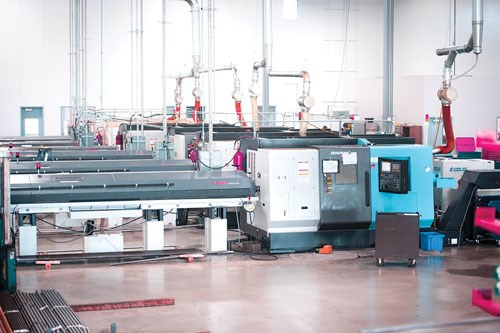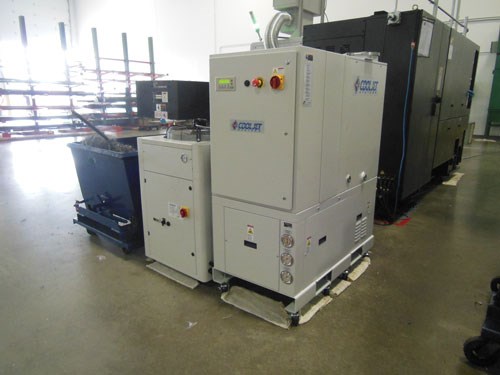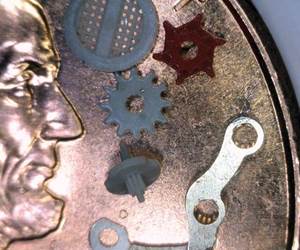A Youthful Approach to Production Machining
Growing up in the industry helped this young shop owner learn key strategies for getting the most from his machines.
Like Jordan Spieth, the phenom golfer who has quickly gained recognition as one of the PGA Tour’s top players, JR Lang learned to compete in his own area of specialization at a young age. His dad has been running the machining and stamping departments for a globally recognized OEM for many years, so JR had a lot of opportunities to see first-hand how his dad’s company continuously found ways to produce more parts in less time.
The older Mr. Lang’s company (Otto Engineering, Carpentersville, Illinois) has been doing lights-out manufacturing since the early 90s, perhaps before the term was even coined. In those days, 11-year-old JR would ride with his dad to the shop on weekends to follow him around, stopping to check material supplies and critical dimensions on the machines. It was during this period of his life that his passion, not only for machining, but for entrepreneurial business management, began to blossom.
He knew he wanted to have his own shop one day, but also realized that a good amount of knowledge and experience would be needed to make it successful. After finishing college, rather than working at his dad’s company, he bounced around a bit in some other jobs, including some time in Germany at machine tool builder Handtmann CNC and back in the U.S. as a rep for a cutting tool manufacturer. But feeling somewhat removed from his area of expertise, JR then moved on to a copper alloy foundry, running its machine shop. Now back to his roots, he was about to spot his golden opportunity.
Building the Foundation
In 2005, after being at the foundry for a couple of years, JR had a friend approach him with a need to fill an order for a large number of parts that his existing supplier was continuously falling short on. Continuing his full-time job at the foundry, JR spent the next 10 months’ worth of nights and weekends subleasing space at a neighboring job shop supplying parts for his first real customer.
He then finally felt comfortable enough to set out on his own, and in 2006, JR founded Midwest Turned Products in Gilberts, Illinois. The company started in a small, 2,000-square-foot industrial unit, but as it quickly grew, was able to expand into adjacent units until it had taken over almost the entire building. Still busting at the seams, at the beginning of 2014 Midwest picked up and moved a few blocks away to its current 20,000-square-foot location.
Driving the expansion was a steady increase in workflow and the associated need for more machines. Midwest now has eight Doosan Puma TT1800SY twin-spindle, twin-turret multi-axis turning centers, six Star SR Swiss turning centers, and a FANUC Robodrill (one of each of these brands has been added within the past year). While the company serves a range of industries (including electronics, agricultural and dental), the majority of its work comes from aerospace and food service.
What really seems to drive the business forward is its philosophy of incorporating automated processes and unmanned machining to get parts complete in one operation with as little human intervention as possible.
Lights Out
JR’s goal is to squeeze optimum production time from all of the equipment on the shop floor. To do that requires efficiency in the personnel as well. Midwest runs two manned shifts, but also keeps the machines running lights out overnight and through the weekends. The company has the strategy down so well, it gets, on average, between 6,000 and 6,300 production hours out of each machine per year (out of a possible 8,760 total hours in a year, that’s between 68 and 72 percent uptime). It runs a high mix of parts, and a typical run is only about 3 or 4 days, so scheduling is important.
“If a job does not require a full unmanned shift to finish, we will evaluate which customer those parts are for and decide if it makes sense to run extra parts to use those machine hours,” JR says. It might seem counterproductive, but if he is confident that the customer will need the extra parts within a reasonable amount of time, he’s willing to hold that inventory to maximize the machining time. “If we have a job that we receive 20 purchase orders for during the course of a year, we’re pretty sure that next order is right around the corner, and it only makes sense to use those machine hours.”
On the other hand, if it’s a new customer or if it’s the first time they’ve run a part and there’s a good chance that part will change, that job will go on the machine early in the week when operators are available. There’s a fine balance between the lean principle and understanding how valuable machine time is. JR doesn’t have a specific formula for making these decisions; it’s more a matter of knowing who the client is and what the component is used for to determine the forecast for that part. “It’s time we’ll never get back on these machines, so we might as well use as many hours as we possibly can,” he says.
Given this approach, it’s not unprecedented that Midwest has run extra parts that it did not need, but JR doesn’t lose sleep over it. In the end, it’s part of the risk that goes into using those hours. “I can’t have the mindset of watching every last piece of material that we’re consuming when I know how valuable those hours are,” he says. “We make up for those lost parts by getting the most out of our machines otherwise.” He knows exactly what each machine costs each day to sit on the floor, whether it’s running or not. While it may hurt to throw away some parts, he feels the upside of overall machine utilization far outweighs any small amount of lost material.
Creative Solutions
JR isn’t afraid to step out of his comfort zone to deliver parts in the most creative and efficient way he can find. One part, for a knife sharpening unit designed for the food service industry, was having a lot of issues with rust because of all the water it is exposed to. Switching to a different grade of stainless resolved the rust issue, but jumped the cycle time from 3 minutes to 19. Because almost all of the cycle time was being consumed by drilling and tapping small-diameter, deep holes, JR decided the best solution was to break his done-in-one rule, machine a turned blank on the multi-axis turning center, and then move the parts to the drill and tap machine (purchased specifically for this job). A robotic arm on the Robodrill handles loading and unloading to allow the job to run for 10 hours unattended. Now the combined cycle time for the part is a far more acceptable 6 minutes.
Innovative approaches to the production process are necessary for Midwest’s micromachining applications as well. One client in Arizona does a lot of military and defense work and approached Midwest with a challenge regarding mating stainless steel parts with a 00-90 thread size.
The customer had developed a case to contain a soldier’s global positioning system (GPS) within and protected by the chest plate of his or her body armor, yet allowing easy external access to the unit’s buttons. Simply pressing the buttons engages the GPS.
A typical order for the parts is about 2,000 pieces. Midwest began making the part with tapped holes. JR had located a supplier with a tap that size, but the tap would wear out after only 50 pieces. “The flutes on the tap were like the hair on your head, so they’d wear out so quickly on this grade of stainless,” he says. With a cycle time of only about a minute, this job had no chance of fitting into the unmanned environment.
Always looking for a better way, JR moved the part to one of the Star machines, where he can mill the thread with a small helical milling pattern. While this change bumped the cycle time up to 2.5 minutes, the job can now run continuously for the entire part run. So where the part originally could not even run overnight, it now has become the perfect weekend job because the material is stable, the cutting tools don’t wear out, and good parts are there at the end. “Again, we’re not afraid to compromise cycle time for the sake of machine efficiencies and the hours we’re getting out of them,” he says.
Winning Philosophy
According to Schalk van Niekerk, business development executive at Midwest, JR’s success in the business comes from his early introduction to the business. “More than scientific formulas, JR has a certain intuition that developed from growing up in the trade,” Mr. van Niekerk says. “He knows when to adjust his core strategies, and he knows how to keep his employees excited and motivated and how to make his customers sense they are the most important thing.”
Ultimately, a unique selling proposition is necessary to be successful in business. To be able to run 24/7, unattended, is an important part of the Midwest Turned Products business structure because it creates high efficiency and, therefore, competitively priced work. Not a lot of businesses are willing to take that leap unless they know it’s going to work for them. JR has that confidence.
Related Content
A History of Precision: The Invention and Evolution of Swiss-Style Machining
In the late 1800s, a new technology — Swiss-type machines — emerged to serve Switzerland’s growing watchmaking industry. Today, Swiss-machined parts are ubiquitous, and there’s a good reason for that: No other machining technology can produce tiny, complex components more efficiently or at higher quality.
Read MoreUnderstanding Micro-Milling Machine Technology
Micro-milling can be a companion process to turning-based production machining. This article looks at some of the technologies that go into a micro-milling machine and why they are important to successful operation.
Read MoreAddressing Micro-Boring Challenges
This boring bar/tool holding system for Swiss-type lathes is said to offer high rigidity and positioning repeatability. In addition, the boring bars can be changed out using no hand tools.
Read MoreLaser Technology "Turns" into a Turning Tool
This new technology uses a laser to act as a cutting tool to "turn" parts from solid barstock. This high-speed precision turning machine is especially useful for micromachining, enabling high accuracy for small, complex parts that are often delicate and difficult to machine when implementing conventional turning processes.
Read MoreRead Next
Simplifying Fire Prevention
Every machining facility should have a plan in place for fire prevention. An automatic fire suppression system installed on a machine can be the solution.
Read MoreDo You Have Single Points of Failure?
Plans need to be in place before a catastrophic event occurs.
Read MoreEmerging Leaders Nominations Now Open
Here’s your chance to highlight a young person in your manufacturing business who is on the path to be a future leader moving your company forward.
Read More












.jpg;maxWidth=300;quality=90)





.jpg;maxWidth=300;quality=90)







